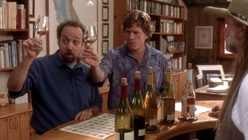In 2004, amid the latest Harry Potter, Shrek, and Spider-Man, themoviegoing public was shocked to discover they could actually see an American filmmade for grownups. In an era of widespread pandering to the child-in-us-all, criticslauded Alexander Payne’s comedy-drama Sideways for its adult themes andcharacters. As the critic David Ansen put it, “…Sideways stays resolutely life-size.And that, in this age of hype and hyperventilation, may be the most radical thing aboutit.” In addition to the financial achievement of grossing $110 million worldwide on aproduction budget of $16 million, Sideways has to be one of the best films evermade about wine; those who have seen it are probably doomed to hear the echo ofPaul Giamatti’s brief tirade against Merlot whenever they consider that varietal on a menu.
The film was Payne’s third in an escalating triptych of delving into middle-aged maleangst. In his dryly satirical semi-cult fave Election, the main character wascomically and blissfully unaware of his extreme American ordinariness, and his descentinto loserdom barely chipped away at an unrelenting optimism bordering on delusion.About Schmidt, a low-key star vehicle for Jack Nicholson, upped the self-awarenesslevel a notch, as the lifelong folly of a superannuated executive’s life slowlyseeped into his — and the audience’s — consciousness.

But in Sideways, Paul Giamatti, playing a guy who looks like Paul Giamatti, isalready in full-blown rueful mode when the film begins. The movie tracks a one-weekvacation in which his character, Miles, heads to the wine country of Santa Ynez Valley,in Santa Barbara County, with his pal Jack (Thomas Haden Church) on the eve ofJack’s wedding.
Miles is a junior high school English teacher, divorced three years and still pining for hisex. He’s also a talented but failed novelist, dependent on anti-depressants, and anabuser of wine. Jack is an actor who hit his peak as a regular on a soap opera but hasnow been relegated to commercials (“mostly nationals”). The two, of course, areopposites: Jack is a puerile loose cannon who effuses frequent bursts of cockeyedoptimism; Miles over-thinks everything and projects only doom. Jack is shallow, Miles anintellectual. Jack is confidently oversexed; Miles looks like he’d rather be anywhere elsewhen the lights are low. Jack is getting into a marriage he seems to not really want;Miles is out of one he still wants to be in. In short, Jack’s all id, Miles depressed superego. For Miles, the long-planned trip is a chance to school his buddy on the one thinghe’s still got a confident purchase on: wine. Jack, on the other hand, despite (or due to)his imminent nuptials, has the sole goal of getting laid.







